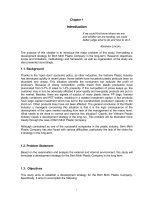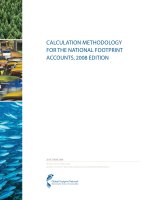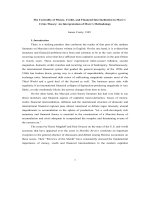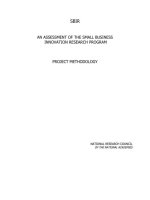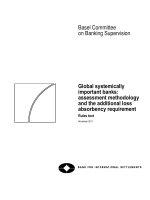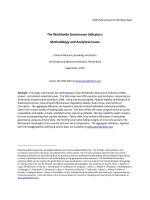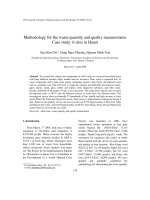The wyckoffs vsa methodology
Bạn đang xem bản rút gọn của tài liệu. Xem và tải ngay bản đầy đủ của tài liệu tại đây (7.45 MB, 227 trang )
The Wyckoff’s VSA Methodology
Trading in harmony with smart money!
Course Book + Illustration Book
This Book is authored by Muhammad Uneeb
1|Page
Written by Muhammad Uneeb
Contents Table
1. Preface
2. Introduction to FOREX Trading
3. Psychology of Trading
4. RISK MANAGEMENT
5. Introduction to Technical Analysis
6. Wyckoff’s Volume Spread Analysis Theory
7. Support and Resistance Explained
8. Dynamic Trends and Trend Lines
9. Interpretation of Volume Spread Analysis with respect to Dow Theory
10. References
11. Conclusive Remarks
2|Page
Written by Muhammad Uneeb
Preface
I started my trading journey back in 2011. Since its inception I have been switching from one
system to another in the hope to acquire Holy Grail of trading FOREX. My system hopping
phase would go like this:
I would pick up one system, back test it and after getting some successful back test results, I
would go and trade it on live account. Unfortunately, the system would not perform well on a
live account and I would end up blowing up my trading account. Then again I would transit to
another system and the entire process was repeated again. This process was repeated until 2016
for 5 years without getting any real success in trading.
I always pondered what is going wrong! Why my strategies are not working? What is the missing
piece of the puzzle in my trading? I built a very highly effective money management and risk
management plan and implemented it in my trading. I saw a dramatic change in my trading
results but still I was not convinced with my trading performance until I reached one point where
I decided to give up trading and do something better in my life. I have tried and perfected many
systems over time including Harmonics Patterns Trading, Elliot Waves Trading, Price Action
Trading and even incorporated fundamental analysis in my trading. Even then the problem
persisted which lead me to the system hopping phase over and over again.
Until one evening, I found out about the volume spread analysis which helps in tracking the
smart money activity and helps in understanding the market manipulation areas. This attracted
me so much that I started reading extensively on this subject and carried out extensive amount of
research. The efforts I put into to process finally paid off and I finally reached my aha and
eureka moment in trading using VSA. Having perfected this system, I decided to write down an
easy to understand comprehensive guide on this subject and deliver my knowledge to others. I do
not guarantee success by trading this methodology. However, if you really put in efforts to
understand this methodology and practice extensively then there is no excuse of not making
money consistently by trading FOREX.
I hope you will enjoy reading this book and I strongly believe this book will change your trading
game forever and embark you on a successful consistently profitable trading journey!
I have written enough about the transition to the VSA system. Let’s discuss the actual
development process of the VSA.
I just want to discuss how Wyckoff's VSA methodology was developed in 2 years’ time by me. I
was very disappointed by some of the courses and information available online. It is so
misleading that it does not teach anything of value. After being frustrated, I decided to develop
my own approach finally.
The first book which takes the credit in the development was Japanese Candlesticks charting
techniques by Steve Nison. His book is without a shade of doubt, the best book available on this
subject as Steve Nison was one of the developer of Candlestick charting.
3|Page
Written by Muhammad Uneeb
The second series of books I read were on technical analysis. They were as follows:
1) The Art and Science of Technical Analysis by Adam Grimes
2) Technical Analysis of the Financial Markets by John J Murphy
3) Technical Analysis Explained by Martin J Ping
These book are the best technical analysis contents available so far.
The Third Set of Books I read were on chart patterns. These books include:
1) Getting Started in Chart Patterns by Thomas Bulkowski
2) Trade Chart Patterns like pro by Suri Duddella
Then I progressed towards the price action in general and the best book in this category for me
is this book:
1) The Ultimate Price Action Trading Guide by Mangi Madang
2) The Price Action Course by R.Kay
Then the last phase was to read extensively on VSA. I read following books on this subject:
1. Master the Markets by Tom Williams
2. Trading in the Shadow of Smart Money by Gavin Holmes
3. The Complete Guide to Volume Price Analysis by Anna Coulling
All these books and a lot of practice helped me in developing my own Wyckoff's VSA approach. I
have practised my concepts by back testing and forward testing for more than 10,000 hours.
Understanding that Trading is not an easy way to become rich, I have reflected my efforts in this
book and my video course so that you develop correct perspective and expectations in trading.
Once you have developed the right process oriented mind-set and have stopped believing in the
marketing gimmicks of the industry painting a false image of trading being an easy way to make
money, you have set yourself a part from others and made yourself ready to hunt for money
professionally.
4|Page
Written by Muhammad Uneeb
Provided that you tuned your mind-set’s frequency with mine, I will drop you a warm welcome
message:
Welcome to the hardest game in the world. Unfortunately, you're playing with some of the
sharpest, fastest, most intelligent, well informed, stubbornly irrational and in many cases,
unethical minds in the world.
You're up against the computer that can react faster than you.
The trader who has more experience than you.
The fund that has more money than you.
The insider that has more information than you.
The others that will misinform you.
The inner voice that will do it's best to undo you.
So, leave all your dreams of making quick and easy money, behind. The first aim is survival.
Your absolute first goal is to learn how to stay in the game.
You can only do this by mapping the territory.
By understanding how the enemy thinks and acts.
By having a solid game plan.
And by picking your battles very, very carefully.
Kind regards,
Muhammad Uneeb.
5|Page
Written by Muhammad Uneeb
Introduction to Forex
• Forex stands for Foreign Exchange
• Forex Trading is the speculation of the change in exchange rates of the currency
pairs.
• Exchange Rate consists of two parts: The Base Currency and The Quote
Currency
Base Currency/Quote Currency = Exchange Rate
Let’s consider an example:
In EUR/USD, EUR is Base Currency and USD is Quote Currency
In USD/JPY, USD is Base Currency and JPY is Quote Currency
As a general rule, Base Currency is the left hand side currency of currency pair and
Quote Currency is the right hand side currency of the currency pair.
Let’s consider one more example:
EUR/USD = 1.19000
Here 1.19000 is the exchange rate of EUR/USD and we read it like this:
EUR/USD = 1.19000
1 EUR = 1.19000 USD
• Here is another rule to consider in forex:
Base Currency is directly proportional to the Exchange Rate. This means that when
Base Currency is strengthening then the exchange rate will increase and when the
base currency is weakening then the exchange rate will decrease.
Quote Currency is inversely proportional to the exchange rate. When the Quote
Currency is strengthening then the exchange rate will decrease and when the Quote
Currency is weakening then the exchange rate will increase.
6|Page
Written by Muhammad Uneeb
• The unit of measurement to express the change in value between two currencies
is called a “pip.” If EUR/USD moves from 1.1050 to 1.1051, that .0001 USD rise
in value is ONE PIP. A pip is usually the last decimal place of a quotation.
• Points is the smallest unit of measurement of exchange rate. Point has a unique
relation with pip. This relation is as follows: Points = Pip * 10. 2 Pips = 20 Points,
3 Pips = 30 Points and so on.
In the past, spot forex was only traded in specific amounts called lots, or basically
the number of currency units you will buy or sell.
The standard size for a lot is 100,000 units of currency, and now, there are also a
mini, micro, and Nano lot sizes that are 10,000, 1,000, and 100 units respectively.
Standard Lot = 100,000 units
Mini Lot = 10,000 units
Micro Lot = 1,000 units
Nano Lot = 100 units
As you may already know, the change in currency value relative to another is
measured in “pips,” which is a very, very small percentage of a unit of currency’s
value.
To take advantage of this minute change in value, you need to trade large amounts
of a particular currency in order to see any significant profit or loss.
Let’s assume we will be using a 100,000 unit (standard) lot size. We will now
recalculate some examples to see how it affects the pip value.
USD/JPY at an exchange rate of 119.80: (.01 / 119.80) x 100,000 = $8.34 per pip.
USD/CHF at an exchange rate of 1.4555: (.0001 / 1.4555) x 100,000 = $6.87 per
pip.
7|Page
Written by Muhammad Uneeb
In cases where the U.S. dollar is not quoted first, the formula is slightly different.
EUR/USD at an exchange rate of 1.1930: (.0001 / 1.1930) X 100,000 = 8.38 x
1.1930 = $9.99734 rounded up will be $10 per pip.
GBP/USD at an exchange rate of 1.8040: (.0001 / 1.8040) x 100,000 = 5.54 x
1.8040 = 9.99416 rounded up will be $10 per pip.
Your broker may have a different convention for calculating pip values relative to
lot size but whichever way they do it, they’ll be able to tell you what the pip value
is for the currency you are trading is at that particular time.
As the market moves, so will the pip value depending on what currency you are
currently trading.
• Spread is the difference between bid and ask prices. Bid Price is the markdown
price on the exchange rate done by the broker. You sell at the bid price. Ask price
is the mark up price on the exchange rate done by the broker. You buy at the ask
price. Spreads are the way the brokers make money from each trade execution
done by the trader. You can also understand spread as the operational cost of the
trade execution. Brokers also charge commission per trades besides charging
spreads.
Let’s consider an example:
Let’s assume you are trading on EUR/USD currency pair and the spreads on this
pair is 1.5 pips at the moment. So this means when you execute buy order on the
current market price, your buy order will not be executed on the current market
price. Instead, it will be executed at 1.5 pips above the current market price.
Similarly, when you execute sell order on the current market price, your sell order
will not be executed on the current market price. Instead, it will be executed at 1.5
pips below the current market price.
• Forex Market is the largest financial market in the world with average daily
turnaround volume of 5 Trillion USD. This means that daily 5 Trillion USD are
exchanged, traded and transacted in Forex. Forex Market is decentralized market
which means that it is not registered on any particular stock exchange. Since forex
market is decentralized, it has no real volumes. The only volume we have is tick
volume which is proxy to real volumes. Statistics and studies show that Tick
Volumes are 90% correlated to the real volumes.
8|Page
Written by Muhammad Uneeb
• Forex market is driven by the participation of Buyers and Sellers. Buyers and
Sellers activity creates imbalance between supply and demand which in fact moves
the market. If there are more buyers than sellers at any given time then it means
that Demand is greater than Supply and so the market will move in the upward
direction. If there are more sellers than the buyers then it means Supply is greater
than the Demand and so the market will move in the downward direction.
• Forex Market is traded 24/5 (24 Hours a day and 5 days a week). The market is
closed during Weekends, Bank Holidays and Special Holidays (For instance:
Easters, Thanks Giving Day, Christmas, Labour Day, etc.)
• Going long means anticipating the increase in price or placing buy orders.
• Going short means anticipating the decrease in price or placing sell orders.
• Participants of Forex Trading:
1) Investment Banks
2) Commercial Banks
3) Hedge Funds
4) Governments
5) Central Banks
6) Tourists and Travellers
7) Commercial Companies
8) Money Exchangers
9) Retail Traders
10) Retail Brokers
11) Institutional Brokers
9|Page
Written by Muhammad Uneeb
• If you want to learn more about forex trading then visit the links below:
1) />2) />3) />4) />5) />
• Which Currency Pairs to Trade:
Majors:
1. EUR/USD
2. GBP/USD
3. USD/JPY
4. NZD/USD
5. AUD/USD
6. USD/CAD
7. USD/CHF
8. EUR/GBP
9. EUR/JPY
10. EUR/CHF
11. GBP/JPY
12. GBP/CHF
13. CHF/JPY
10 | P a g e
Written by Muhammad Uneeb
Minors:
1. EUR/AUD
2. EUR/NZD
3. EUR/CAD
4. GBP/AUD
5. GBP/NZD
6. GBP/CAD
7. NZD/JPY
8. AUD/JPY
• Which Timeframes to trade: 5 Mins, 15 Mins, 30 Mins, 1 Hour, 4 Hours, and
Daily.
11 | P a g e
Written by Muhammad Uneeb
•
Forex Market Hours:
12 | P a g e
Written by Muhammad Uneeb
13 | P a g e
Written by Muhammad Uneeb
Trading Psychology
Forex traders have to not only compete with other traders in the forex market but
also with themselves. Oftentimes as a Forex trader, you will be your own worst
enemy. We, as humans, are naturally emotional. Our egos want to be validated—
we want to prove to ourselves that we know what we are doing and we are capable
of taking care of ourselves. We also have a natural instinct to survive. All of these
emotions and instincts can combine to provide us with trading successes every now
and then. Most of the time, however, our emotions get the best of us and lead us to
trading losses unless we learn to control them. Many Forex traders believe it would
be ideal if you could completely divorce yourself from your emotions.
Unfortunately, that is next to impossible, and some of your emotions may actually
help improve your trading success. The best thing you can do for yourself is learn
to understand yourself as a trader. Identify your strengths and your weakness and
pick a trading style that is right for you.
In this section, you will learn about the following four psychological biases that
may be affecting your trading results and what you can do to overcome them:
• Overconfidence bias
• Confirmation bias
• Anchoring bias
• Loss aversion bias
Overconfidence Bias
Overconfidence bias is an over-inflated belief in your skills as a Forex trader. If
you ever find yourself thinking to yourself that you have got everything figured
out, that you have nothing more to learn and money is yours for the taking in the
forex market, you probably suffer from an overconfidence bias.
Dangers of Overconfidence
Overconfident traders tend to get themselves into trouble by trading too frequently
or by placing extremely large trades as they go for the home run. Inevitably, an
overconfident trader will end up either trading in and out and in and out of trades—
churning the trader’s account—or risking too much on the one trade that goes bad
and wipes out most of the trader’s account.
14 | P a g e
Written by Muhammad Uneeb
Are You Overconfident?
If you want to know if you have any overconfidence tendencies, ask yourself,
“Have I ever jumped right back into a trade I had just been stopped out of not
because I saw another entry opportunity but because I couldn’t believe I was
wrong?” You can also ask yourself, “Have I ever put more on a trade than I
normally would because I was just sure this trade was going to be the one?” If you
have, you need to be aware of those tendencies
Overcoming Overconfidence
The best way to overcome an overconfidence bias is to establish a strict set of riskmanagement rules. These rules
should at least cover how many trades you will allow yourself to be in at one time,
how much of your account you are willing to risk on any one trade and how much
of your account are you willing to lose before you take a break from trading and
re-evaluate your trading strategy. By limiting the number of trades you are willing
to be in and the amount of risk you are willing to take, you can spread your risk out
evenly over your portfolio.
Anchoring Bias
Anchoring bias is a propensity to believe that the future is going to look extremely
similar to the status quo. When you anchor yourself too closely to the present, you
fail to see the dramatic changes that are possible as currency pairs fluctuate and the
underlying fundamentals shift.
Dangers of Anchoring
Anchored traders tend to get themselves into trouble by convincing themselves that
the current trend will never end and a reversal in the economic strength of a
particular country is next to impossible. Alas, they become emotionally attached to
the previous trend of a currency pair, and they continue to place trades that go
against the new, current trend. With each trade, they lose more and more money
because they are bucking the trend.
Are You Anchoring?
If you want to know if you have any anchoring tendencies, ask yourself, “Have I
ever lost money because I couldn’t accept that the trend had ended?” If you have,
you need to be aware of that tendency.
15 | P a g e
Written by Muhammad Uneeb
Overcoming Anchoring
The best way to overcome anchoring is to look at multiple time frames on your
charts. If you usually trade on the hourly charts, take a look at the daily and weekly
charts every now and then to see where some of the longer-term levels of support
and resistance are and what the longer-term trends look like. You should also take
a look at the shorter-term charts to see when the shorter-term trends are reversing.
Broadening your perspective will help you avoid anchoring yourself to any one
point.
Confirmation Bias
Confirmation bias is a propensity to look only for the information that confirms the
beliefs that you already have. For instance, if you believe the EUR/USD is going to
go up, you will look for the news, the technical indicators and the fundamental
factors that support your belief.
Dangers of Seeking Confirmation
Traders who over-actively pursue confirmation of their beliefs tend to miss key
warning signs that would normally have protected them from unnecessary losses.
In an attempt to build a case for their beliefs, traders miss the facts. Ultimately, this
leads to them fighting the trend and losing money with each ill-conceived trade.
Do You Seek Confirmation?
If you want to know if you have any confirmation bias tendencies, ask yourself,
“How often do I look for signs that I may be wrong in my analysis?” If your
answer is rarely or never, you may be a confirmation seeker, and you need to be
aware of those tendencies.
16 | P a g e
Written by Muhammad Uneeb
Overcoming Confirmation Bias
The best way to overcome confirmation bias is to find someone, or a group of
people, you can talk to about your trading. Hopefully the person, or people, you
talk about your trading with will not always agree with you. Talking with traders
with diverse perspectives and ideas will help you look at your trades from multiple
angles. Sometimes you will strengthen your convictions by talking with other
traders. Other times, talking with your trading partner will cause you to change
your mind. Keeping an open mind will help you catch new moves and avoid
holding on too long to past beliefs.
Loss Aversion Bias
Loss aversion bias is based on the theory that the pain that is caused by losing
$1,000 is greater than the joy that comes from gaining $1,000. In other words, fear
is a more powerful motivator than greed.
Dangers of Loss Aversion
Traders who fear losses are much more likely to hold onto losing positions than
traders who are able to accept short-term losses and move onto other, moreprofitable trades. Holding onto losing positions jeopardizes the stability of your
portfolio by not only incurring losses but also keeping you out of better trades.
Do You Fear Losses?
If you want to know if you have any loss aversion tendencies, ask yourself, “Have
I ever held onto a losing trade past the point where I knew I should have gotten out
because I hoped the currency pair would turn around and wipe out my losses?” If
you have, you need to be aware of those tendencies.
Overcoming Loss Aversion
The best way to overcome a loss aversion bias is to trade with physically set stop
loss orders. Many traders tell themselves that they will trade with a mental stop
loss—a stop loss level that they think about and promise themselves they will act
on if the currency pair ever reaches it. All too Often, however, traders fail to act on
their mental stop losses. They let their emotions get in the way, and they start
rationalizing their choice to stay in the trade until it turns around. As soon as you
17 | P a g e
Written by Muhammad Uneeb
enter a trade, you should set your stop loss order. Take your emotions out of the
picture.
Fear of Missing Out
FOMO stands for "Fear of Missing Out" and a FOMO trade is simply a trade you
enter out of fear of missing the move. When a stock experiences sudden volatility,
it can make some traders very anxious. You may feel like you are faced with an
opportunity that will not present itself again, and, of course, you don't want to miss
the move. Due to the high volatility, you are forced to make a fast decision: do I
enter or leave it alone?
Sensory Derived Bias:
We pull information from around us to form an opinion or bias and this allows us
to function and learn, in many cases. However, we must realize that, while we may
believe we are forming an opinion based on factual evidence, often we are not. If a
trader watches the business news each day and forms an opinion that the market is
going higher, based on all the available information, he may feel he came to this
conclusion by stripping away the media personnel's opinions and only listening to
the facts. However, this trader still may face a problem: When the source of our
information is biased, our own bias will be affected by that. Even facts can be
presented to give credence to the bias or opinion, but we must remember there is
always another side to the story. Furthermore, constant exposure to a single
opinion or viewpoint will lead individuals to believe that that is the only practical
stance on the subject. Since they are deprived of counterevidence, their opinion
will be biased by the available information.
Avoiding the Vague:
Also known as fear of the unknown, avoiding what may occur, or what is not
totally clear to us, prevents us from doing many things and can keep us locked in
an unprofitable state. While it may sound ridiculous to some, traders may actually
fear making money. They may not be aware of it consciously, but traders often
worry about expanding their comfort zone, or simply fear that their profits will be
taken away through taxes. Inevitably, this may lead to self-sabotage. Another
source of bias may come from trading only in the industry with which one is most
familiar, even if that industry has been, and is predicted to continue, declining. The
trader is avoiding an outcome because of the uncertainty associated with the
investment.
18 | P a g e
Written by Muhammad Uneeb
Another common tendency relates to holding onto the losers too long, while selling
the winners too quickly. When prices fluctuate we must factor in the magnitude of
the movement, to determine if the change is due to noise or is the result of a
fundamental effect. Pulling out of trades too quickly often results from ignoring the
trend of the security, as investors adopt a risk-averse mentality. On the other hand,
when investors experience a loss, they often become risk seekers, resulting in an
over held losing position. These deviations from rational behaviour lead to
irrational actions, causing investors to miss out on potential gains, due to
psychological biases.
Tangibility of Anticipation:
Anticipation is a powerful feeling. Anticipation is often associated with an "I want"
or "I need" type of mentality. What we anticipate coming is some time in the
future, but the feeling of anticipation is here now and it can be an enjoyable
emotion. It can be so enjoyable, in fact, that we make feeling anticipation our
focus, instead of achieving what it is we are anticipating in the first place.
Knowing that a million dollars is going to show up on your doorstep tomorrow
would create a fantastic feeling of excitement and anticipation. It is possible to
become "addicted" to this feeling and thus put off taking payment.
While easy money delivered to the door is more than likely to be grabbed by the
eager homeowner, when things are not quite as easy to come by, we can fall into
using the feeling of anticipation as a consolation prize. Watching billions of dollars
change hands each day, but not having the confidence to follow a plan and take a
chunk of the money, can mean we subconsciously decided that dreaming about the
profits is good enough. We want to be profitable, but "wanting" has become our
goal, not profitability.
What to Do About It
Once we are aware that we may be affected by our own psychology, we realize it
may affect our trading on a subconscious level. Awareness is often enough to
inspire change, if we do in fact work to improve our trading.
There are several things we can do to overcome our psychological roadblocks,
beginning with removing inputs that are obviously biased. Charts don't lie, but our
perceptions of them may. We stand the best chance of success if we remain
objective and focus on simple strategies that extract profits from price movements.
Many great traders avoid the opinions of others, when it comes to the market and
realize when an opinion may be affecting their trading.
19 | P a g e
Written by Muhammad Uneeb
Knowing how the markets operate and move will help us overcome our fear, or
greed, while in trades. When we feel we have entered unknown territory where we
don't know the outcome, we make mistakes. However, if we have a firm
understanding, at least probabilistically, of how the markets move, we can base our
actions on objective decision making.
Finally, we need to lay out what we really want, why we want it and how we are
going to get there. Listen in on the thoughts that run through your head right when
you make a mistake, and think about the belief behind it—then work to change that
belief in your everyday life.
The Problem of System Hopping or Switching
One of the major stumbling blocks all traders face at some time is the nasty habit
of switching systems whenever they suffer a string of losses.
It was certainly a problem for me in the past, borne out by the many excellent
strategies and systems on this site, that I tried out at one time or another, only to
move on when the inevitable losing streak arrived.
Why do we do this? It comes down to what is known as Regency Bias. This
concept describes the way we feel about our current trading.
If we’ve just had a string of wins, we are highly likely to consider ourselves Gun
Traders who can do no wrong! In this frame of mind we are more likely to stick
with the current system we are using.
However, if we have a string of losers, our frame of mind changes radically and
rapidly. Doubt sets in, compounded by Fear. Our heart rate elevates, we kick
ourselves over trading decisions, and above all we begin to question the validity of
the system or strategy we are currently employing. We begin to wonder:
“Hey, it’s just lost five times in a row, that can’t be good! Maybe there’s
something out there that hardly ever loses?”
So we go on and do our research, choose another system and begin to trade it. At
first our suspicions about the last system are confirmed as we rack up a series of
wins with the new system. We congratulate ourselves for a wise decision. We are
incredibly intelligent for having found this new system that hardly ever loses!
Wow, we’ve really arrived as a trader now.…
And of course, when the inevitable string of losses comes along – as it always does
with ANY system – the old cycle of doubt and fear sets in once more and we go
20 | P a g e
Written by Muhammad Uneeb
looking for yet another Holy Grail system to trade. We have sadly and pathetically
come to resemble a hamster on a wheel, a long fall from the state of grace of
Master Trader!
The way to escape from this horrible cycle is a process of:
1) Back testing. What you who are about to test must have shown some kind of
promise in back testing. Back testing is a complex concept that’s really outside the
scope of this post – which concerns itself with the next step in the process – but
you must have some kind of confidence that the strategy you’re about to test may
produce results.
Though back testing is outside the scope of this post, I will say that I usually just
rely on a manual, “eyeball” approach these days, as the parameters I use such as
pivots, round numbers, support and resistance levels etc. can be easily plotted on
past charts.
2) Forward Testing. Otherwise known as live trading, using either a demo account,
or preferably a live micro account (generally speaking, live accounts give more
accurate and reliable results).
3) Strategy Verification. We do this by logging the results of all our trades, most
commonly in an Excel spreadsheet. I have included an example from my own back
testing verification below.
4) Trade or Discard. Based on our analysis of the trades logged in the above step,
we decide whether to persist with the strategy or not.
Note that sometimes even if a strategy proves to be profitable over the period of
testing and verification, we may choose to discard it anyway. For example, if we
chose to test the strategy based on a certain time frame that we were able to trade,
and now we are no longer able to trade that timeframe, it would be foolish to
persist with the strategy.
Another reason for discarding a profitable strategy at this stage is that, though it
may have shown a profit, you may judge the return on your effort too poor to
continue. This was the case with the strategy depicted in my own trading log
below. I’ve included screenshots of the two relevant Excel spreadsheet tabs.
The strategy was for an automated system I had devised, based around news
trading. In some ways it worked quite well. For example, I was able to leave trades
in the market overnight (my time) for news events that occurred in the New York
21 | P a g e
Written by Muhammad Uneeb
session. Overall, these trades proved profitable, even when I left orders in the
market with the automated strategy, just prior to Non-Farm Payrolls data releases.
However, in the end I discarded this strategy because once I had done the 100
trades required to “prove/disprove” the approach, I realised I’d be better off
(mostly) if I traded the events manually.
The bottom line is this: never stop trading a strategy just because it’s losing. Have
some methodology in place that you use with every trade you take, that verifies
whether or not the strategy is a loser over the longer term.
Trading psychology tips for beginners
If you’re a new trader trying to make sense of forex market movements and
making money while you’re at it, the whole experience can be exciting and
overwhelming at the same time. This is why it is important to work on your trading
psychology from the very start of your trading endeavour.
Perhaps one of the most important things to remember when you’re starting out is
to just take it easy. It can be tempting to try all technical indicators all at once or
trade every single top-tier news release out there, but you might run the risk of
overdoing it and feeling burned out later on. Stick with what you’re comfortable
with and just add what you learn along the way.
Another thing to keep in mind is to know yourself. Make sure you come up with a
trading strategy that is in tune with your personality and your risk preferences. For
instance, if you thrive in fast-paced movements and if you’re comfortable with
managing many open positions at once, then you could look into scalp trading
techniques. On the other hand, if you get easily stressed with quick price
movements and would rather just check your charts every now and then, swing
trading might be better for you.
Lifestyle considerations must also be taken into account when coming up with a
trading strategy so as to not set yourself up for stress or failure. If you are planning
on trading part-time while holding on to your day job, then you could look into
trading techniques that won’t require you to be in front of your trading platform all
the time.
Easier said than done is the trading psychology recommendation to stay on top of
your emotions. After all, we are human and we can’t help but sometimes give in to
poor decision-making when our minds are clouded with fear or greed. The trick in
22 | P a g e
Written by Muhammad Uneeb
forex trading is to keep an objective mind set to be able to focus on what the
market is telling you instead of letting emotions cloud your judgment.
This particular skill takes time to master and even experienced traders can still be
guilty of being too emotional, which is why it is also important to constantly
remind yourself to isolate these emotions when trading.
Staying disciplined goes hand in hand with trading psychology, as this enables you
to stick to your strategy and risk management rules. After all, it can be tempting to
deviate from your plan when the markets are going haywire but with the right mind
set and discipline, you should be able to focus on the right action steps to take.
Lastly, it is important to note that keeping a trade journal is one of the best ways to
work on your trading psychology, and this is a habit that must be started by
beginner traders from the very start. This allows you to keep track of your profit
and loss, trading decisions, trade strategies, and even the factors that influenced
your decisions. In analysing these, you can be able to identify your strengths and
build on them while working on your weaknesses.
How to make the most of your Demo Trading
Beginner traders are often recommended to start with a demo trading account
before risking real money on a live account. However, there are also many who
question whether this step is necessary as demo trading has several stark
differences with live trading, particularly in the trading psychology aspect.
Despite that, demo trading is a good way to practice one’s newly learned trading
skills without the risk of losing real money. It is also an effective method of putting
a new trade strategy to the test and monitoring its results before making
adjustments. While demo trading does not exactly replicate the emotions and stress
involved in live trading, there are several ways to make the most out of this
experience.
The main difference in demo trading and live trading is that the latter typically has
more pain involved when one loses a trade. Not only did you have a wrong or
poorly implemented trade idea, but you also lost real money in the process. When
it comes to demo trading, even though there is no real money involved yet, you can
try to feel the pain by coming up with real-life penalties when you lose a trade. For
instance, you can have a small jar wherein you put a dollar for every lost trade so
that you are reminded that trading decisions have a real money aspect tied to it.
23 | P a g e
Written by Muhammad Uneeb
Another way to make the demo experience feel more like live trading is to assign
grades to each aspect of the trade. You can evaluate your entries and exits, whether
you were able to press your advantage or cut your losses, or if you stuck to your
risk management rules. Deductions can apply if you gave in to emotions and
deviated from your plan in the middle of volatile market movements. From there,
you can be more conscious of your decision-making and apply the same kind of
self-assessment when you are trading live.
Bear in mind though that the temptation to give in to fear of losing or greed is
much stronger when real money is on the line so it is important to master this
aspect of trading psychology on a demo level then simply repeat the process even
when real money is being traded.
As discussed in the earlier section, it is crucial to keep a trading journal even as
you are trading demo. This way you can easily identify your usual mistakes and
weaknesses, then be able to work on them before transitioning to live trading. You
can list your emotions involved when you make a trade decision or change in
plans, then be in a better position to evaluate if you made the proper action or if
you just had a panic reaction.
When you are able to take the leap and start trading live, just remember all the
lessons you learned in demo trading and don’t be too overwhelmed about risking
real money. As mentioned earlier, it is crucial in trading psychology to focus on
the process and not the profits as you are learning the ropes.
Are you ready to trade real money?
If you think you are finally ready to make the transition from demo trading to
having a live account, then you should also be psychologically prepared for it. Not
only will you have real money on the line, your emotions might also have a bigger
impact on your trading decisions.
A good rule of thumb to remember before going from demo to live is to ensure that
you have had a good trading run for at least three months. Of course this time
frame can vary depending on how much time you spent learning about trading but
it is a reasonable length of time to make sure that you have had a strong grasp of
basic trading concepts and are able to make consistent profits. This can also ensure
that you’ve spent a considerable amount of time getting in sync with market
movements and that you can hold your own even when real money is at risk.
Another factor to consider is whether or not you’ve tried various trading styles and
found the most appropriate one for you. As mentioned in an earlier section, this has
24 | P a g e
Written by Muhammad Uneeb
to do with your personality and lifestyle, as you should be using a strategy that you
are comfortable with. When you have found the trading style that suits you, it will
make for a smoother transition from demo to live, as you simply have to go for
consistent execution instead of having to experiment with different trading
techniques with a live account.
To make sure that you will be keeping track of your improvements both in profits
and in your trading mind set, you should also have a trading journal up for review
when you transition from demo to live. Before forking over your hard-earned cash,
it would be a good practice to have a quick review of your trading journal from
demo to remind yourself of which aspects of your trading you can still improve on
and to take note of the strengths you should play.
Lastly, you can gain enough confidence to carry on with your demo success in live
trading if you have the numbers to back it up. Unless you’ve been able to make
consistent gains and have a good expectancy in demo trading, you might just wind
up doubting your trade decisions when you start trading live. This is why it is
crucial to get your risk management practices right and have rules for maximizing
your winners and minimizing your losses. With a positive track record, you can be
able to place full trust in your trading strategies and be confident to put this to use
on a live account.
Psychological differences of demo and live trading
Some beginner traders in their first few months of live trading end up surprised
that they are having difficulties replicating their success in demo trading to a real
account. This is perhaps a result of underestimating the psychological differences
between demo and live trading and not being able to make the proper preparations
for it.
For one, having real money on the line can mean stronger emotions. While you
were able to master controlling your fear of losing or your greed while demo
trading, these emotions can have a larger impact when you are trading a live
account. After all, it is not easy watching real money being lost during a losing
trade so the temptation to give in to these emotions can be stronger. Some traders
might even wind up reverting to their old trading habits of setting stops too tight or
not sticking to one’s trade plan when starting out with live trading.
This can be avoided by treating your demo trading mistakes as though they
happened on a live account. Although demo losses don’t translate to losing money,
25 | P a g e
Written by Muhammad Uneeb
